The top sights in Padua (Padova) can be seen in a few hours but few visitors would regret staying longer to explore this lovely historic town with major art, architectural and religious sites.

Padua (Padova) in the Veneto region of Northern Italy, near Venice and Verona, is particularly famous for the marvelous early Renaissance fresco cycle painted by Giotto in the Scrovegni Chapel and the large Basilica of St Anthony. In addition to these UNESCO World Cultural Heritage-listed sites, further sights worth seeing in Padua include the historic university, a pleasant old town with medieval architecture, Renaissance art, lively piazzas, and one of Europe’s oldest botanical gardens. Hotels in Padua are often far cheaper than in nearby Verona and especially expensive Venice.
Timing and Planning to See Top Sights in Padua

The two top must-see sights in Padua of historical, art, and religious importance are at opposite ends of the town center:
- The Scrovegni Chapel (and Eremitani Church and Museum) is the sight closest to the train station, so I prefer seeing this last when traveling by train.
- The Basilica of St Anthony (some parts close for lunch), the Prato del Valle, and the botanical gardens are at the opposite end of Padua but easily reached by tram (scan bank card when entering) or around half an hour’s walk.
If visiting Padua on a day trip or stopover, keep in mind that you must buy essential time-slot reservation tickets for the Scrovegni Chapel at least a day in advance. (Evening viewings are sometimes still bookable in person in Padua on the same day.)
From the train station, the tram takes around 5 minutes to Eremitani (Scrovegni Chapel), 5 more to Romani (city center), and about ten more to the Basilica and Prato del Valle. Walking takes around 10, 5, and 15 minutes, if not stopping for sightseeing.
Save with the Urbs Picta Card

Admission fees for many sights in Padua are surprisingly high, especially when compared to what may be seen in other cities for the same money. The Urbs Picta card offers good value if planning to see several UNESCO World Cultural Heritage Sites. It covers all the sights below (except the university) and unlimited tram rides.
The price of the 48h card is covered by a visit to the Scrovengi Chapel, Palazzo della Ragione, and using the tram once. Buy from the tourist office, or even easier, online when making reservations for the Scrovegni Chapel.
Scrovegni Chapel (Cappella degli Scrovegni)
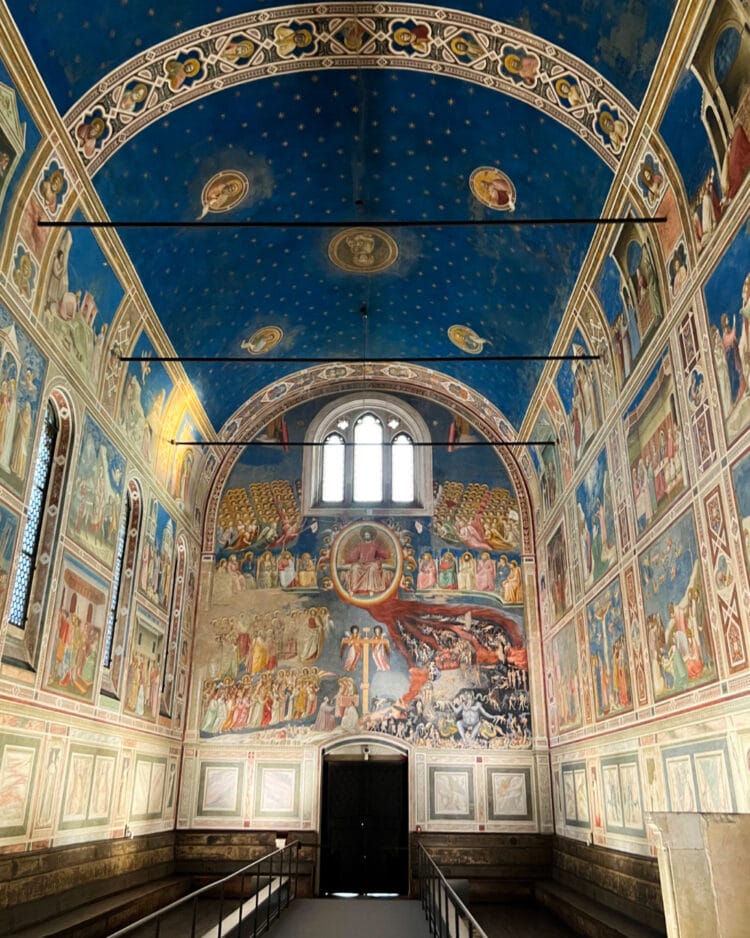
A UNESCO Masterpiece of Early Renaissance Art
If you see only one thing in Padua, make it the Scrovegni Chapel — plan your visit around time-slot reservations to see the Giotto frescoes here.
This modest-looking building hides a world-changing treasure inside — a cycle of frescoes by Giotto di Bondone, painted around 1305. These vibrant scenes from the lives of the Virgin Mary, her parents (Joachim and Anne), and Christ are considered the beginning of Renaissance art and includes the first emotive kiss in Western painting.

Tips for Visiting the Scrovegni Chapel in Padua:
- Reservations are required and should be booked at least one day in advance. (Evening slots are sometimes available for in-person booking in Padua.)
- Only 25 people are allowed in at once to spend 20 minutes with the frescoes.
- Day-time tickets include admission to the Musei Civici agli Eremitani.
→ See also How to Buy Tickets for the Scrovegni Chapel and a Description of the Giotto Frescoes.
Eremitani Complex Sites
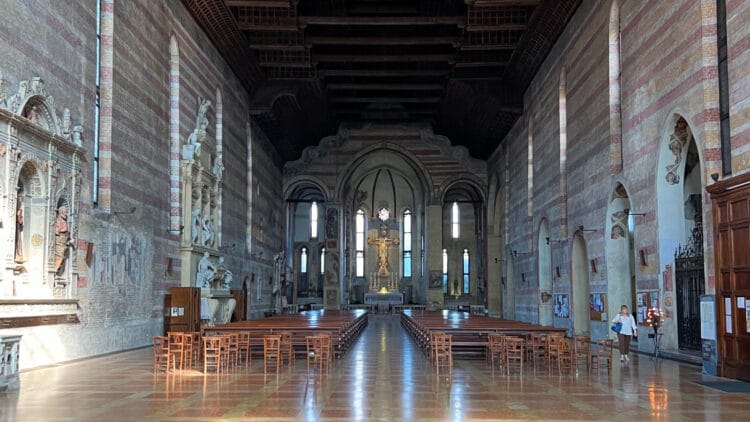
Admission to the Scrovegni Chapel is via the Eremitani Civic Museum. Daytime tickets for the chapel include entry to the Eremitani Museum and, except for Mondays, the Palazzo Zuckermann.
The Musei Civici agli Eremitani display art and archaeological finds. The gallery includes lesser-known works by many famous Venetian artists, but with limited time, better ones may be seen elsewhere, especially in the Galleria dell’Accademia in Venice.
The Palazzo Zuckermann houses a museum of applied arts and a large collection of coins and medals.
Though severely damaged in WWII, the Church of the Eremitani is still worth visiting, especially to see the fragments of frescoes by Andrea Mantegna, an early Renaissance master. Admission is free (and opening hours are long), making it a good stop when arriving too early for the Scrovegni Chapel time slot.
Basilica of St Anthony (Basilica di Sant’Antonio di Padova)
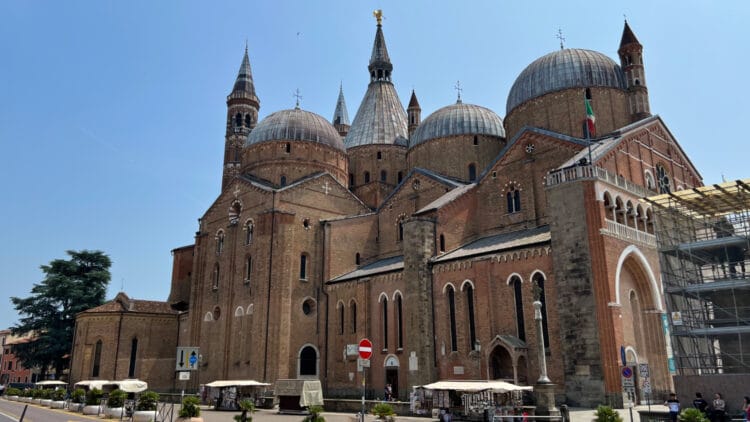
A Major Pilgrimage Site and Spiritual Landmark
A focal point of religious life in Italy, this grand basilica is dedicated to Saint Anthony, one of the most venerated saints in Catholicism. The basilica attracts millions of pilgrims annually but the art and architecture are also of interest to less religious visitors. (Don’t confuse this basilica with the large cathedral or Duomo di Padua, which is in a different part of the city and not particularly noteworthy.)
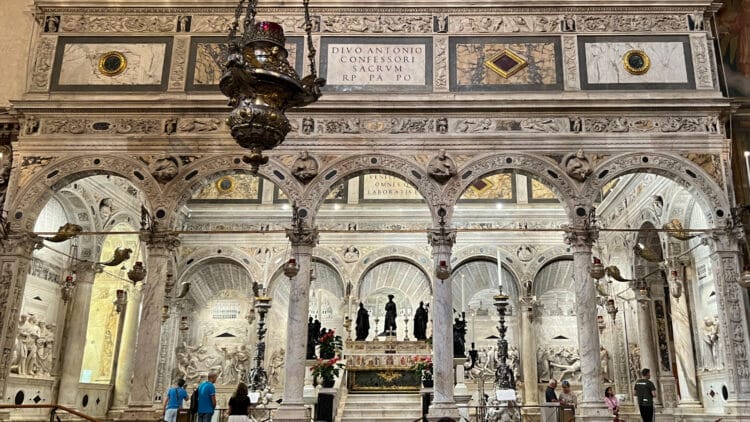
The architecture blends Romanesque, Gothic, and Byzantine elements. The basilica has a beautifully decorated interior. Don’t miss:
- The Tomb of St Anthony in the Capella del Santo, a High Renaissance masterwork.
- The Chapel of the Relics, holding Saint Anthony’s tongue and jawbone — a bit bizarre but clearly of importance to some religious visitors.
- Donatello’s bronze sculptures on the high altar.
- Beautifully decorated chapels and intricate vaulting, especially in the choir and apse areas.
- Three large cloisters — the museums may be of lesser interest to most visitors.
- The equestrian statue of Gattamelata by Donatello outside, a masterpiece of Renaissance sculpture — it is being restored and may still be covered.
- Frescoes in the St George Oratory and School (some by Titian) — enter from the main plaza.
Although the main church is open daily from 6:15 to 18:45, some museums and chapels are open only Tuesday to Sunday from 9:00 to 13:00 and 14:00 to 18:00. Closures for masses and unscheduled services are less likely in the afternoon.
Prato della Valle

One of the Largest Squares in Europe
Measuring over 90,000 square meters, Prato della Valle is Europe’s second-largest square. This elliptical public space is lined with statues of famous citizens, flanked by canals, and surrounded by historical buildings.
The square is honestly not that interesting when there is no festival or market taking place. The large piazzas in the center (Dei Signori, Della Frutta) are more interesting and a better choice for a meal or an aperitif.
However, it is worth taking the tram from the station and getting off here to have a glimpse of the square before walking two blocks back to St Anthony’s Basilica or the botanical garden
Botanical Garden of Padua (Orto Botanico di Padova)
The World’s Oldest Academic Botanical Garden
Established in 1545, Padua’s botanical garden is the oldest in the world still in its original location. It was created to help students distinguish medicinal plants from poisonous ones.
Today, it’s a UNESCO World Heritage Site and home to:
- Over 6,000 species of plants
- High-tech greenhouses
- Ancient trees, including a palm planted in 1585
The garden is a tranquil escape, especially in spring and summer. However, admission is around €10, so not the best choice when simply looking a park to relax in.
Sights in the Center of Padua
The center of Padua is around a 15-minute walk from the station or from the basilica area. The tram stop here is Ponti Romani.
Although the old town is pleasant enough, with several large piazzas, the main reasons for visiting Padua are the Basilica of St Anthony and the Scrovegni Chapel. The other sights are definitely of lesser importance.
University of Padua and the Anatomical Theatre
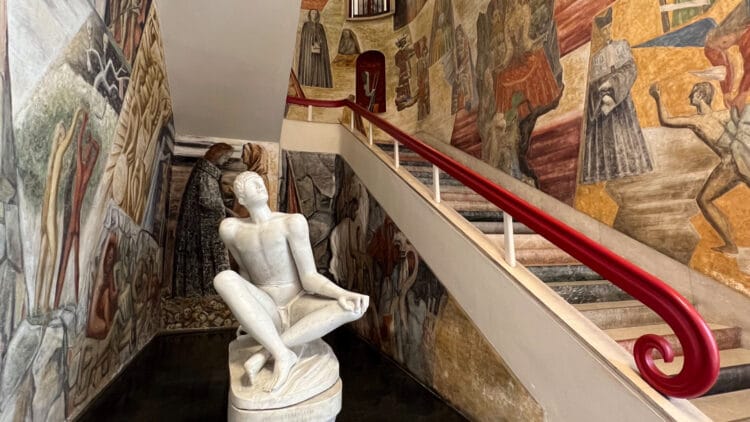
A Cradle of Science and Learning
Founded in 1222, the University of Padua is one of the world’s oldest universities and has hosted minds like Galileo Galilei, who taught here for 18 years.
Within the university, you can visit:
- The Palazzo Bo, the historic headquarters.
- The Anatomical Theatre (Teatro Anatomico), built in 1594, the oldest surviving anatomical theater in the world.
- The Aula Magna, a beautifully decorated great hall.
Take a free peek into the courtyards, even if not planning to visit the most interesting parts that require tickets or guided tours.
Caffè Pedrocchi
The Historic “Café Without Doors”
Since opening in 1831, Caffè Pedrocchi has been more than just a café — it’s been a center of intellectual and political life. Known as the “café without doors” because it was open day and night until 1916, it served as a gathering spot for students, writers, and revolutionaries.
Inside, you’ll find:
- Elegant 19th-century decor
- The Risorgimento Museum on the upper floor
- The famous “Caffè Pedrocchi” drink — espresso with mint cream
Stop here for a stylish coffee break and a taste of Padua’s revolutionary spirit.
Palazzo della Ragione

A Medieval Marvel with a Unique Hall
Located between Piazza delle Erbe and Piazza della Frutta, the Palazzo della Ragione was once the city’s town hall and law court. Today, it boasts one of the largest medieval halls in Europe, known for its wooden roof shaped like a ship’s hull and extraordinary frescoes.
Highlights include:
- A massive wooden horse, a replica of Donatello’s Gattamelata
- Fascinating astrological frescoes restored in recent years
- Bustling markets under the arcades (free)
It’s an architectural and historical gem that showcases the power and wealth of medieval Padua. However, for the €10 admission fee, you don’t get to see much more than just the very impressive hall.
Other Old Town and Center Sights
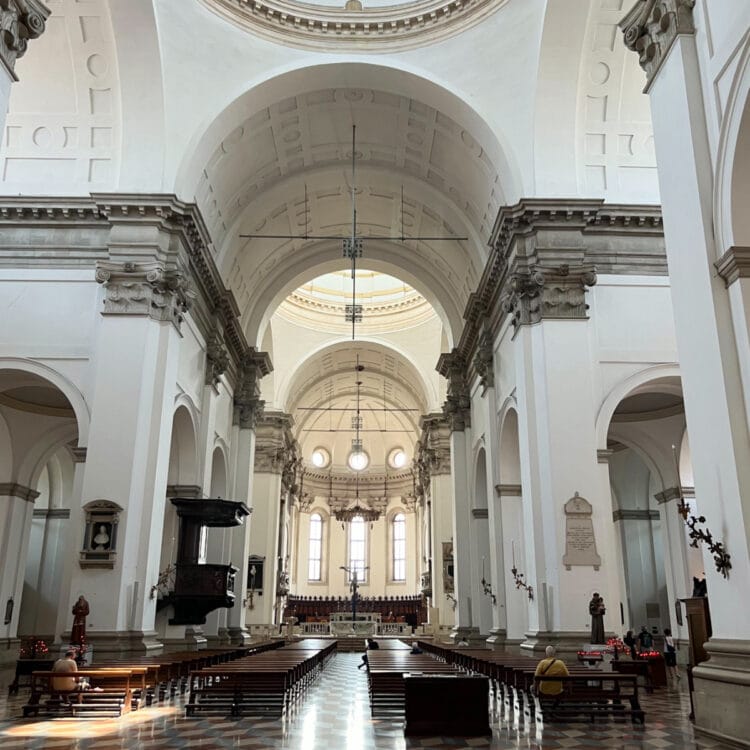
The Duomo (Cathedral) is large but not particularly interesting — don’t confuse it with the Basilica of St Anthony, which is in a different part of Padua. The small baptistery has further magnificent frescoes but it is seen with the rest of the Diocesan Museum. Admission is €12 (or Urbs Picta Card).
See the three large piazzas in the old town area and visit the free market arcades under the Palazzo della Ragione — many stalls are closed in the afternoon.
Practical Tips for Visiting Padua
- Getting There: Padua is just 30 minutes by train from Venice and well connected by rail from Bologna, Milan, Verona, Ferrara, and Ravenna.
- Getting Around: The city center is very walkable. You can also use the tram or rent a bike.
- Best Time to Visit: Spring (April–June) and fall (September–October) offer pleasant weather and fewer crowds. Summer months can be very hot (and busy).
- Where to Stay: Hotels in Padua are likely to be cheaper than in Venice or Verona.
More on Padua near Venice in Italy
Padua (Padova) is a popular day-trip excursion destination from Venice, but the art and architecture here are worth a journey:
- → Top Sights to See in Padua (Padova)
- → Visit the Basilica of St Anthony — free, long opening hours.
- → How to Buy Tickets for the Scrovegni Chapel in Padua — although not very difficult to secure compulsory time-slot reservations, tickets must be bought a day in advance!
- → Giotto’s frescoes in the Scrovegni Chapel, which include the Life of Joachim and Anne: Parents of the Virgin Mary
- → By Train to Padova (for an easy day-trip or stopover from Venice)
- → Book Hotels in Padua
- → Book Luggage Storage near Padova Station